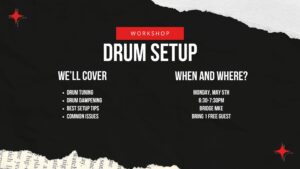When listening to your favorite songs, you might notice a pattern in how they unfold. Most songs follow a structure that helps create emotional impact and keeps listeners engaged. In this post, we’ll break down the key sections of a song and provide examples of how they work in popular music.
1. Intro
The intro sets the mood and introduces the key musical elements of a song. It can be instrumental or include vocals, providing a preview of the song’s overall tone and style. Often, intros are designed to capture attention quickly, sometimes using unique sounds, gradual builds, or abrupt starts to engage listeners immediately. While typically shorter than other sections, the intro plays a crucial role in establishing the identity of the song.
Examples:
- “Smells Like Teen Spirit” – Nirvana: Starts with a quiet, clean guitar riff before exploding into the full song.
- “Rolling in the Deep” – Adele: Opens with a muted drum beat and vocals, creating anticipation.
2. Verse
The verse tells the story or conveys the main message of the song. Typically, each verse has the same melody but different lyrics, allowing the narrative to progress while maintaining musical continuity. Verses provide details, emotions, and context that set up the impact of the chorus, often creating a sense of build-up and anticipation for the song’s climax.
Examples:
- “Someone Like You” – Adele: The verses build the emotional story leading to the chorus.
“Lose Yourself” – Eminem: Each verse intensifies the storytelling.
3. Pre-Chorus (Optional)
A short section that builds tension before the chorus, often introducing variations in melody or rhythm. The pre-chorus serves as a bridge between the verse and chorus, enhancing the song’s flow and making the transition more dynamic. It can introduce a sense of anticipation or urgency, using different chord progressions, vocal delivery, or instrumental changes to heighten the listener’s engagement before the chorus hits.
Examples:
“Teenage Dream” – Katy Perry: The pre-chorus (“Let’s go all the way tonight…”) builds energy before the chorus.
“Livin’ on a Prayer” – Bon Jovi: The pre-chorus (“We gotta hold on to what we’ve got…”) creates anticipation.
4. Chorus
The most memorable and repeated part of the song, containing the main message or “hook.” The chorus typically features the song’s catchiest melody and most impactful lyrics, making it the emotional and musical high point. It often contrasts with the verse by being more dynamic, using stronger instrumentation, and sometimes shifting in key or rhythm to stand out. This section is designed to be easy to sing along with, reinforcing the song’s theme and making it resonate with listeners long after the song ends.
Examples:
- “We Will Rock You” – Queen: The chorus is iconic and chant-like.
“Uptown Funk” – Mark Ronson ft. Bruno Mars: The chorus (“Don’t believe me just watch!”) is catchy and high-energy.
5. Post-Chorus (Optional)
A short section after the chorus that reinforces the hook, often instrumental or with repeated vocal phrases. The post-chorus serves as an extension of the chorus, emphasizing the song’s central theme and maintaining energy before transitioning to the next section. It often features a simplified melody or chant-like repetition that makes the hook even more memorable. Some songs use the post-chorus to introduce slight variations in lyrics or instrumentation, keeping the momentum going and preventing the track from becoming overly repetitive.
Examples:
“Shape of You” – Ed Sheeran: Repeats the melodic “Oh—I—oh—I—oh—I—oh—I…”
“Blinding Lights” – The Weeknd: Features an instrumental melody following the chorus.
6. Bridge (Middle 8)
A contrasting section that offers a new perspective musically and lyrically, often building tension before returning to the chorus. The bridge typically introduces a shift in chord progression, tempo, or dynamics, offering a break from the repetition of the verse-chorus pattern. It can present a fresh lyrical angle, evoke heightened emotions, or create suspense, making the return to the final chorus feel more impactful. In some songs, the bridge may even serve as a climax, adding a dramatic element before resolving back into the main structure.
Examples:
“Halo” – Beyoncé: The bridge (“Everywhere I’m looking now…”) adds an emotional peak.
“Shake It Off” – Taylor Swift: The spoken-word bridge (“Hey, hey, hey…”) changes the dynamic.
7. Instrumental (Solo or Breakdown, Optional)
A section featuring instrumental performance, such as a guitar solo or a synth break, which may replace a verse or bridge. Instrumental sections allow musicians to showcase their technical skills and add an expressive, non-lyrical element to the song. These sections can range from subtle, atmospheric breaks to intense, high-energy solos that create a climactic moment in the track. Some instrumental sections use improvisation, while others follow structured melodies that complement the song’s theme and mood. In genres like rock and jazz, solos are often a signature feature, while electronic music may use instrumental breakdowns to build anticipation before a drop.
Examples:
“Hotel California” – Eagles: Ends with an iconic twin-guitar solo.
“Purple Rain” – Prince: Features an extended emotional guitar solo.
8. Outro (Coda)
The ending of a song, which can fade out, repeat the chorus, or introduce new elements for closure. The outro serves as a way to wrap up the musical journey, providing a sense of resolution or leaving listeners with a lasting impression. Some outros gradually diminish in volume, creating a fading effect, while others bring in a powerful final statement with new lyrics or an instrumental flourish. The choice of outro style can influence how a song lingers in the listener’s mind, whether through a soft, reflective finish or an abrupt, dramatic conclusion.
Examples:
“Hey Jude” – The Beatles: The “Na-na-na-na” outro lasts for minutes, reinforcing the song’s emotional impact.
“Bohemian Rhapsody” – Queen: Ends with the haunting “Nothing really matters…” before a soft piano fade-out.
Conclusion
Understanding song structure can deepen your appreciation for music and even help if you’re a songwriter yourself. The combination of these sections creates a compelling journey for listeners, making songs memorable and impactful.
Do you have a favorite song with an interesting structure?
More Blog Posts

Rhythm Guitar Mastery: Strumming and Riff Techniques for Pop and Country
You know that feeling when a song just clicks — when the beat feels like it’s syncing with your heartbeat, and the chords seem to

Home Recording on a Budget: Recording Your Practice Sessions
You’ve been working hard on your music—nailing that tricky chord change, perfecting your drum fills, polishing your vocals. But how do you really know if

Drum Setup Workshop
Drum Setup Workshop We are announcing our next upcoming workshop! Many drummers struggle with tuning and best setup practices. With so many variables and no